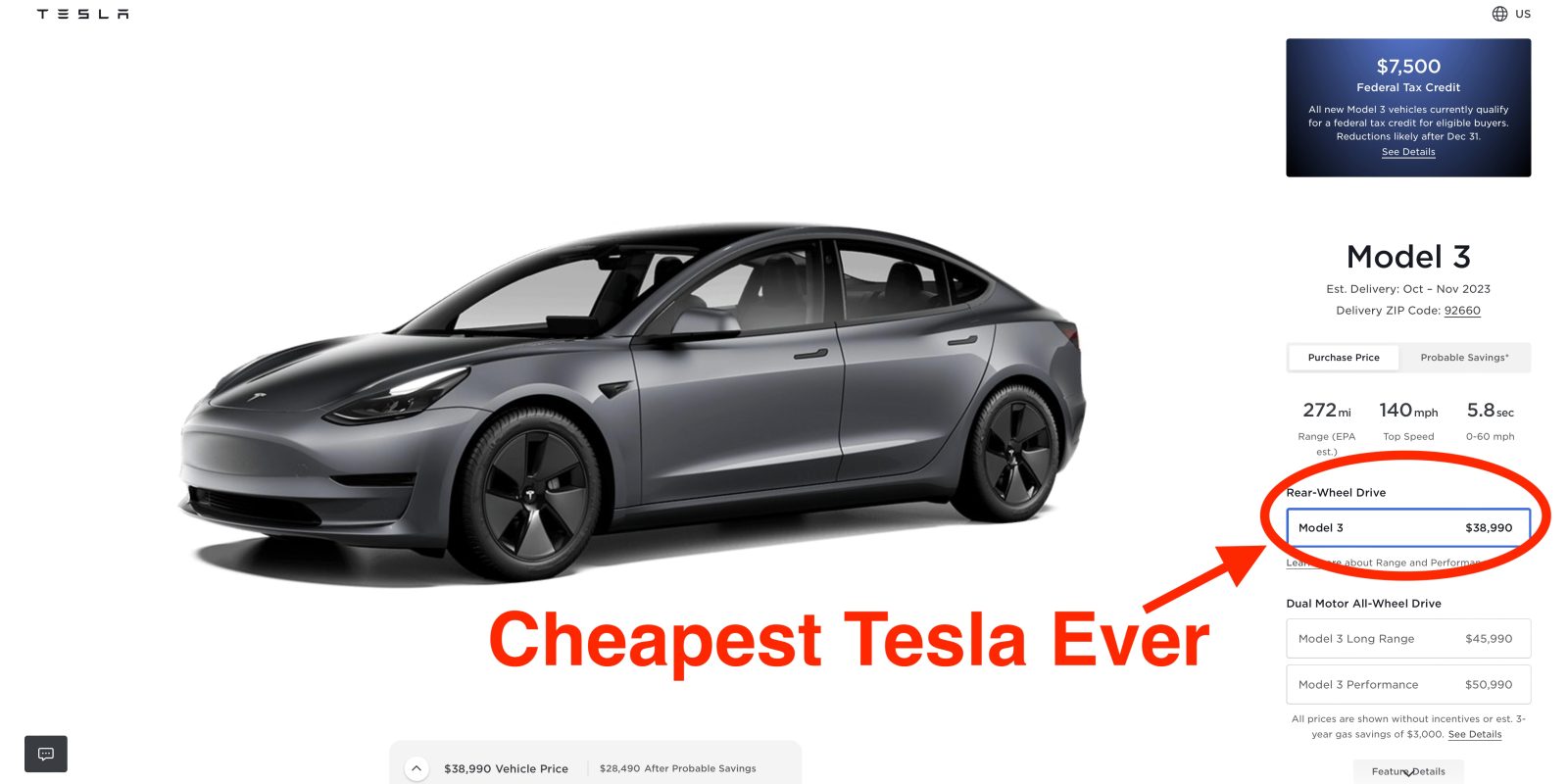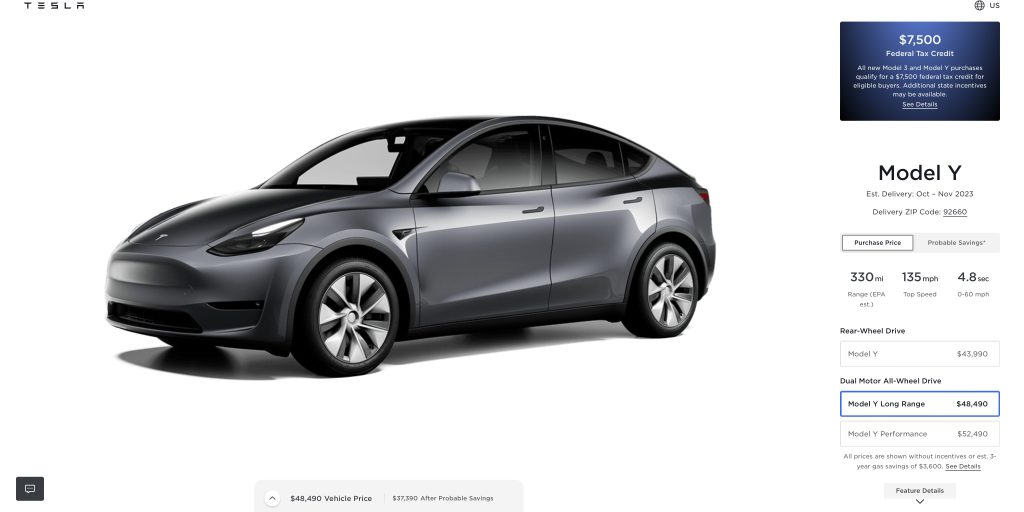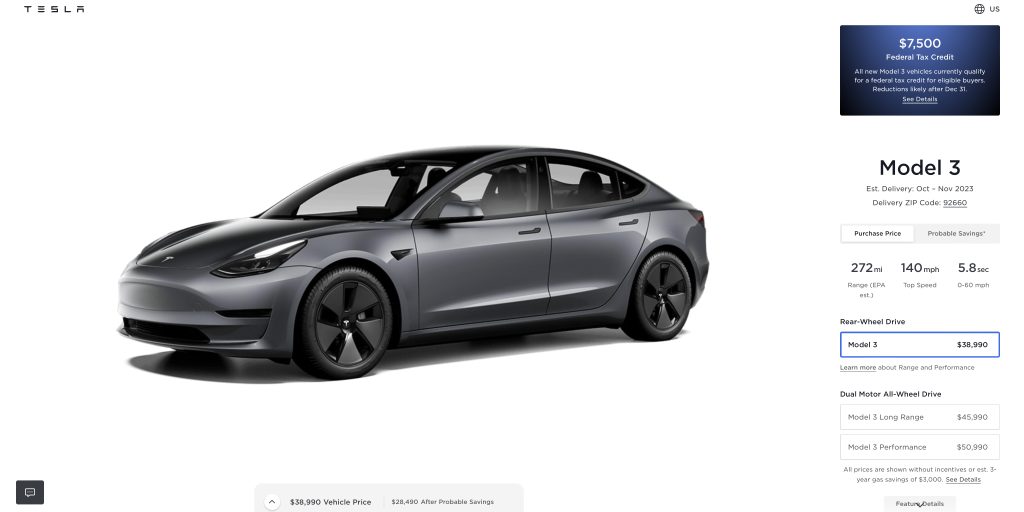
Tesla prices have been falling all year, and today we’ve got another price cut to report on most trims of Tesla’s most popular models, leaving the Model 3 at the lowest price it’s ever been.
Model Y – Long Range & Performance are $2k cheaper
The Model Y Long Range and Model Y Performance are both now listed for $2,000 less than they were earlier today, with the Model Y Long Range going for $48,490 and the Model Y Performance going for $52,490 on Tesla’s website.
Previously, the models started at $50,490 and $54,490 respectively.
The change comes days after Tesla introduced the cheapest Model Y the US has seen, the new Model Y Rear-wheel drive which starts at $43,990. That model was not subject to today’s $2k price drop, and remains at the same price it was introduced at earlier this week.

Model 3 is now the cheapest Tesla ever
The Model 3 has also seen a price reduction, with all three trims getting discounted as compared to earlier today. The Model 3 Rear-wheel drive and Long Range versions both get a $1,250 price cut, and the Performance model is down $2,250 from previous pricing.
These models now start at $38,990 for the RWD, $45,990 for the LR and $50,990 for the Performance model. Previously they sold for $40,240, $47,240 and $53,240 respectively.
The new prices mean that with even modest state, local or regional tax credits, on top of the $7,500 federal credit, a new Model 3 could cost less than $30k for the right buyer. This is the cheapest new Tesla ever, save the questionably briefly-available $35k Model 3 – though between inflation and lower tax credit availability, today’s Model 3 is an even better deal than that one would have been.

The Model 3 recently got a big refresh with lots of changes in foreign markets, though the refreshed “Highland” Model 3 is not expected to be available in the US until next year. So Tesla probably feels the need to sweeten the pot a little for buyers who might otherwise wait for the new version to come out.
This is the latest in a long line of Tesla price cuts, starting in January but continuing with several more this year. Most recently, the company took a big chunk off Model S and X prices and also cut the price of FSD by $3k.
In addition to this, most Teslas now qualify for Inflation Reduction Act tax credits, which Tesla previously could not access after it ran out of the previous EV credit, so many buyers can receive another $7,500 credit on their federal income taxes. Although this may not last forever – due to the way the tax credit law works, Tesla’s cheapest models which use LFP batteries made in China may lose access to half of the credit next year.
Electrek’s Take
Teslas now cost tens of thousands of dollars less than they did at the end of 2022. Sure, 2022 was on the tail end of a year or two of significant price increases, while the EV market was highly squeezed due to COVID-related supply disruptions, but these drops have still been drastic.
The price drops even resulted in owner protests as recent buyers felt aggrieved at their cars losing thousands of dollars of residual value overnight. Imagine that, protesting in favor of inflation.
The drops have also affected the rest of the EV market, as Tesla’s dominant position as the market and brand leader in EVs, along with its previously industry-high margins mean that it has more room to prevail in a price war against other manufacturers, while still maintaining a brand perception as being a higher class of electric vehicle.
This has resulted in difficulty for other manufacturers trying to sell similar vehicles. We just saw this earlier today, as VW ID.4 quarterly numbers came out. While the ID.4 saw record sales, VW only sold 10,707 EVs in the US in Q3. That’s less than a tenth of the number of EVs Tesla delivered in the US in the same time frame.
The ID.4 is currently cheaper than the Model Y, at a base price of $37,495 (plus destination), but every Tesla price drop eats away at that difference.
And this, I believe, is the source of the current complaints around the industry about “demand problems” with EVs. Many manufacturers are lamenting difficulty in growing sales after having no trouble selling every EV they made in 2021 and 2022. But those manufacturers largely have not been dropping their prices this year, whereas Tesla has (well, VW did offer a cheaper ID.4 model this year, just like Tesla has with the RWD).
To extend on the above example, an ID.4 is an incredibly attractive offer at ~$38k against a Model Y at $66k, especially if you can get the tax credit on the ID.4 and not on the Y. But if you shave an effective ~$25k off the price of that Model Y, that calculus is going to change. Maybe that’s why the Model Y is now the best selling car in the world.
Same goes for comparisons to other vehicles, most of which are around the same price they were last year. But if parts shortages are over, if component materials are much cheaper, and if your competition is shellacking you in sales while still managing to lower prices by five digits multiple times over, maybe a little price competition is in order (and the same applies to industries other than automotive, by the way…).
And despite my personal dislike of Elon Musk’s ridiculous shenanigans, at this point, I would be hard-pressed to say there is any better deal in EVs than the Model 3, or even in cars as a whole. Save perhaps for the excellent Chevy Bolt, which is a screaming deal at a base MSRP of $26,500 in its last quarter of production.
